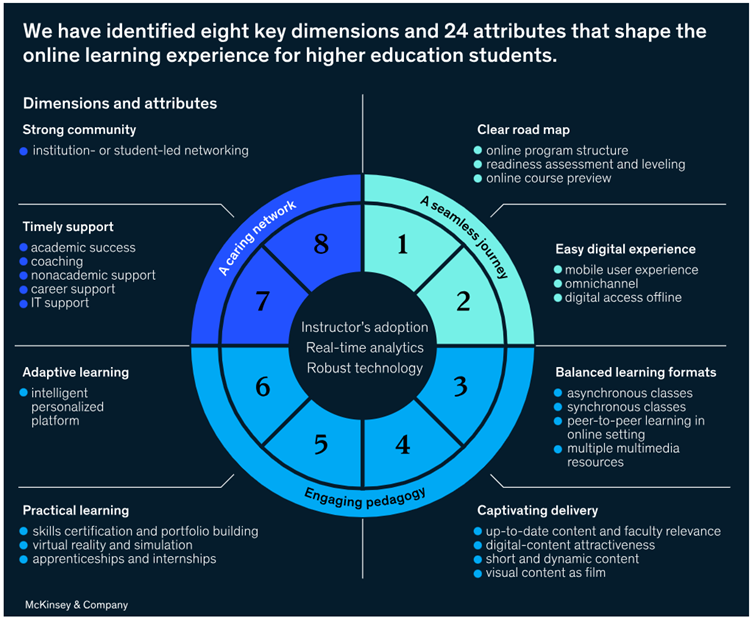
If you weren’t aware of the current issues facing the education market such as the large reduction in student numbers and the knock-on effect on budgets, then hopefully last week’s blog by my colleague Luke will have provided an insight into the challenges facing universities and education providers at present.
With a large proportion of conversations relating back to the topic of the election and what impact (if any) this will bring to the education space, whether through extra funding or visa changes, we’ve heard many say it’s easy to feel helpless against it all.
Therefore, we wanted to take a look at what the digital learning space could be doing to engage the current students and we can look to build an attractive and engaging provision for the future in a space where universities are having to do more than ever before to draw in students.
What student engagement looks like & the benefits
Increasing student engagement seems to be an aim for most institutions, but often one that many will admit can be overlooked in the busy day-to-day of programme production.
It goes without saying, that improving the engagement of current students has a direct positive impact, but a secondary effect that is sometimes overlooked is that it often also proves to be an effective method of increasing the appeal of the learning to future students when the course is generating high-level results. This can be a simple and cost-effective method of increasing the desirability of an organisation’s education offering, as it is often achievable through a change in mindset and strategy.
So, what do we actually mean when we talk engagement? The definition of student engagement is the degree of attention, curiosity, interest, optimism, and passion that students show when they are learning or being taught, which extends to the level of motivation they have to learn (EdGlossary). Studies have shown that there is a moderately strong and positive correlation between overall student engagement and academic achievement, and an analysis of the domains of behavioural, emotional, and cognitive engagement showed that almost all had a positive correlation with students’ academic achievement (Social Behaviour and Personality, 2018).
Student Engagement through Digital Learning
Digital learning has come so far over the years, but many still have a perception of it as a click-through course. Creating learning that allows for ‘power-clicking’, a term I’ve heard across the industry, is something I think most creators can hold their hands up to do, especially when feeling stretched for time and pressured to develop straightforward/beginner-friendly pieces of learning. However, in reality, if a course allows for power-clicking it will always be the easy option for a learner to take and naturally one that most opt for over truly engaging with the content.
“I never like seeing courses that lock learning down to a series of clicks. I think if learners are trying to get to the end as quickly as possible, we’ve probably already failed to provide them with an engaging learning experience. I don’t expect engagement to suddenly materialise just because we’ve asked them to click on something. It has to start much earlier than this.” Laura Giles, Head of Learning
So, if engagement is what we’re striving for, this poses the question of ‘how do we truly engage the learner?’. There are in fact multiple ways to affect this, and they’re often referred to as the different modes or dimensions of engagement (see below).

Figure 1 – Dimensions of engagement (Redmond et al., 2018).
Redmond et al wrote about the topic in 2018 and the above illustration is an effective visual showing the different methods he covered which can affect engagement. Examples of each of the engagement modes, specifically in the space of digital learning, were proposed by Redmond et al such as:

Figure 2 – Redmond Online Engagement Framework for Higher Education
It is all well and good having plans for increasing the engagement, however in order to be able to engage students, we must first have students enrolled and in a position to start the course. So how do we create an attractive offering and ultimately get people through the door?
How to attract them to be able to engage them…
As student numbers have fallen, there’s been a lot of information batted around this year about what learners are actually looking for from digital learning, and therefore different organisations seem to each have taken their own individual approach to creating an attractive, yet effective, learning portfolio.
Although much smaller than in earlier years, convincing students to enrol onto digital learning courses still remains a challenge for the sector. EYs 2024 study of 3000 Higher Education learners found that the application process was vital to this and that digital pathways should be designed in such a way that it takes prospective students through the application within just a few clicks. They also suggested that those who abandon their applications part-way should be intercepted and personally re-engaged to increase levels of enrolment. 80% of those in the study also stated that courses that appeared to improve career prospects and those that adapted to the changes in the topic’s market were extremely attractive to them whilst they were choosing where to enrol.
McKinsey & Company’s 2023 study of 7,000 students across 17 countries identified 8 key dimensions that were important to learners, specifically within the area of digital learning (see below).

Figure 3 – McKinsey & Company
As a market, I can honestly say I think the digital learning space is always seeking to provide nothing but the best for students, and I’m sure many of the above 8 areas are already being addressed in most institutes, but there’s always room for improvement, right?
I am, of course, a recruiter, not a digital learning expert, and therefore a little bit on the outside looking in. However, I truly believe that from what I’ve seen and heard, with a whole lot of resistance, some innovative thinking, and a bit of backing from the government (hopeful, I know!), we can pull through this current downturn.



